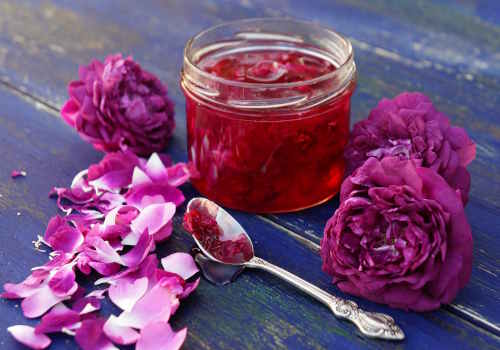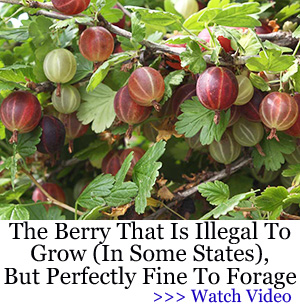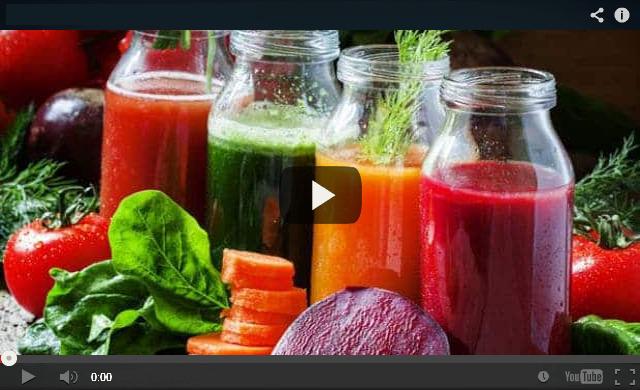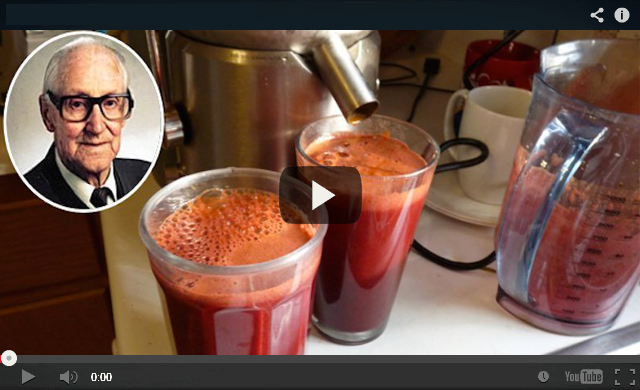Famous Roses is known as important supplier of the Rose de Rescht, the most recommended rose for jam, syrup and tea. It has a very strong fragrance and the color of the petals is pink to purplish red. It is a very beautiful extremely perfumed rose. So, your garden will have a gorgeous ornamental aspect.
OUR INTRODUCTION TO EDIBLE ROSES
The Tyrant and I love growing interesting and unusual varieties of food in our edible organic landscape. Gardens don’t have to be designed as ugly rows of plants.
Our first edible rose plants
One such plant that we initially squabbled about years ago was roses. When The Tyrant informed me that we would be putting in roses that year, I initially protested.
Why should we waste garden space on perennial plants that:
a) don’t produce food, and
b) are typically very disease-prone? Just because rose plants are pretty and smell good wasn’t a good enough justification for me.
However, once The Tyrant educated me on the fact that plenty of rose varieties do in fact make wonderful edibles, I acquiesced. Between us (don’t tell her), I’m glad I listened to her “voice of reason” because roses are actually one of the most multifunctional plants we grow. As I now know, roses aren’t simply edible, they can be downright delicious.
The rose family’s many celebrities
It shouldn’t be too surprising that roses produce edible parts. That’s because roses are part of a famous family chock full of celebrities, plant family that is: Rosacaea.
Roses are closely related to almonds, apples, apricots, cherries, peaches, pears, plums, and other fruit you’ve probably eaten countless times. And some roses produce gorgeous hips (the fruit) with curves that would fit right in on a Kardashian Instagram page. (No, roses are not closely related to the Kardashian family.)
WHAT PARTS OF A ROSE ARE EDIBLE AND HOW DO YOU USE THEM?
Don’t let those thorny branches fool you: nearly every part of a rose plant is edible. Here are the parts of a rose plant you can consume:
- Edible rose leaves
Yes, rose leaves are edible.
Rose leaf harvesting tips
Pick rose leaves when they’re young for best flavor. Pluck them off with your fingernails or use clippers and gloved hands if you’re harvesting from a thornier rose variety.
How to eat rose leaves
You don’t want to eat rose leaves as a salad green, but they are good in a tea leaf mix. On their own, they have a flavor similar to black tea, but they don’t contain caffeine. (There are plenty of other plants you can grow in your garden that do contain caffeine.)
Use rose leaves raw or dried in an herbal tea mix.
- Edible rose buds
Yes, rose buds (the unopened flowers) are edible and LOADED with rose flavor, assuming you’re using a fragrant variety.
Rose bud harvesting tips
We like to pick unopened rose buds on our domesticated plants throughout the spring and summer months. Cut the whole bud off at the base using clippers when the bud is full and just about to begin opening.
We also find small-budded wild roses growing near us that produce a flavor that’s perhaps even better than our large, domesticated varieties. Unlike some of our domesticated varieties that produce throughout the warm months, the wild roses in our area only produces one round of buds in early spring.
Just be sure to leave enough buds on your rose plants so they can produce petals and hips!
How to eat rose buds
We lay our freshly harvested rose buds out in a single layer on a plate or tray to dry indoors under a ceiling fan. After they’re completely dry (2-4 weeks) they can be stored in jars or bags.
Rose buds make an excellent tea, but can also be used as flavoring in other dishes as well.
- Edible rose petals & whole flowers
Yes, rose petals are edible. They’re probably our favorite edible part of the plant due to their unique flavor and vibrant color potential (although there are good edible white-petaled roses).
Rose petal harvesting tips
The nice thing about rose petals is you don’t have to harvest the whole flower to obtain petals. You can simply pull them from the flower head before they begin to brown and fall off the plant.
How to eat rose petals
There are lots of ways to eat rose petals. One thing you might enjoy doing is googling a particular country, region, or ethnic group + “rose petal recipe” to find culturally unique rose petal recipes.
A few of our favorite ways to eat fresh rose petals include:
add fresh rose petals to a salad,
chop rose petals and put them in honey to be used as a spread (popular in Greece),
chopped into a summer sorbet,
candied rose petals,
add rose petals as a colorful dessert garnish.
You can use dried rose petals in teas as well, but they don’t pack nearly the flavor of rose buds
- Edible rose hips
Yes, rose hips are edible.
What has more Vitamin C than oranges and tastes like a tangy apricot? Ripe rose hips. That’s why rose hips are probably our favorite edible part of the rose plant.
Are rose hips a fruit? Like apples, rose hips are technically a “false fruit” since the edible part is actually a swollen part of the stem (receptacle), not a developed ovary.
Each variety of rose produces different sizes, colors, and flavors of hips (see section below for the best varieties). The hips we grow ripen to certain hues of red and orange.
Rose hip harvesting, preparation, and cooking tips
Harvest rose hips when they’re fully orange or red in color (no green remaining). Clip the hip at its base with clippers to remove from the plant.
Cut the hips in half and scrape out the seeds with a blunt knife or your fingernail.
If you don’t have many rose plants, you can store the fresh hips in a freezer bag in your freezer until you’ve collected enough for a recipe (jam, sauce, etc). Or you can dry and reconstitute the rose hips for use in tea, jams, puddings, sauces and more when the need arises.
Rose hips truly are delicious in the above applications, with a flavor most proximate to a tangy apricot (their close relative).
Can you eat raw rose hips? Yes, you can eat raw rose hips, but we think they’re better cooked and made into specific rose hip recipes.
EDIBLE ROSE PLANTS: VARIETY SELECTION
As mentioned above, not all roses are created equal in the flavor or easy-to-grow categories.
Over the past 50+ years, roses have been bred/hybridized primarily for ornamental purposes, not edibility. Older rose varieties often have very good rose hips since they were often used/bred for food production as well as ornamental qualities.
When it comes to selecting for edible rose FLOWERS, the intensity of fragrance is key to variety selection. The better the smell, the better the taste.
Own-root versus grafted roses
In addition to edibility and breed, another critical factor in selecting good edible rose plants is own-root vs. grafted roses:
Own-root roses – As the name implies, own-root roses have their own roots, rather than being grafted on to rootstock of another variety. The entire plant, from root to flowering top, is the same variety.
Grafted roses – Grafted roses are the tops of a particular rose variety you’re buying grafted to the root stock of another variety, likely selected for being resistant to certain soil-borne diseases.
We highly recommend getting own-root roses! To save space, we won’t provide a lengthy explanation why here, but instead advise you to read more on this topic from Heirloom Roses if you’re curious.
Best edible roses
Based on our growing experience, research, and discussions with other edible rose enthusiasts, we also highly recommend you get David Austin roses (born 1926 – died 2018). Why?
First, Austin’s incredible breeding work produced robust, disease-resistant plants. Second, he bred for traits that are important for edibility, namely:
highly aromatic flowers,
large hips (usually), and
repeat flowering ability.
Recommended edible rose varieties
It’s important to note that roses are self-fertile, so you don’t need more than one plant to get edible rose hips. The following varieties are each excellent, depending on the edible parts of the rose you most desire and the growth habit you want:
A. David Austin varieties best for edible rose HIPS:
Rosa moyesii ‘Alba’ – Growth habit: bush/shrub | David Austin (DA) description: Large, single, white flowers of silky texture, quickly followed by exceptionally large, orange-red hips. There is a strong Old Rose fragrance. A healthy shrub with vigorous, spreading growth.
Rosa rugosa, ‘Blanc Double de Coubert’ – Growth habit: bush/shrub | DA description: More than 100 years after its introduction in 1892, this rugosa is still treasured in gardens everywhere. It continuously produces pure white semi-double flowers almost all season without a break. Renowned for its intense fragrance. Displays red hips in the fall that are both decorative and useful for vitamin C rich tea, jam and jelly. The plants are tough, vigorous, naturally disease-resistant and hardy through Zone 3. Flower size: 4-5″.
Rosa filipes ‘Rambling Rector’ – Growth habit: climber/rambler | DA description: Bears large heads of small, creamy white, semi-double flowers which eventually fade to white. They have a powerful musky clove scent and are produced in great abundance on strong, dense, twiggy growth. The flowers are followed by masses of small hips in the autumn.
‘Generous Gardener’ – Growth habit: climber | DA description: A rose of delicate charm with beautifully formed flowers, which nod gracefully on the stem. When the petals open they expose numerous stamens, providing an almost water lily-like effect. The flowers are a soft glowing pink at the centre, shading to palest pink on the outer petals and eventually fading almost to white. There is a strong and delicious fragrance with aspects of Old Rose, musk and myrrh. The leaves are a pale, almost greyish green, typical of the Musk Rose group and they stay on until late into the winter. If it is not dead-headed, it produces large, orange hips in the autumn. An extremely healthy variety.
Best David Austin varieties for edible rose FLOWERS (buds and petals):
Our personal favorite rose variety for:
a) vigor,
b) ease of growing organically, and
c) delicious, fragrant, and colorful flowers is ‘Cardinal de Richelieu‘. This is a large rose plant (ours is about 7′ tall x 7’ wide). David Austin’s website describes this rose as “lightly scented,” but we can smell ours from 20 feet away – and the smell is wonderful, as is the flavor.
We’ve found that the gorgeous purple flowers of our Cardinal de Richelieu make delightful drinks with vibrant red-purple color and exceptional flavor. This variety is also extremely hardy and disease-resistant. The only downsides:
1) it’s not an ever-blooming variety
2) it doesn’t produce great hips.
Granted, we only have so much growing room in our gardens so we haven’t tried every rose variety. Here are some other good contenders to consider for edible rose flowers:
Remember… back in those days, there was no electricity… no refrigerators… no law enforcement… and certainly no grocery store or supermarkets… Some of these exceptional skills are hundreds of years of old and they were learned the hard way by the early pioneers.
Today is your chance to be part of saving The lost super food . I wanted to make this information available to every family out there without having to spend years of their lives or thousands of dollars.
So I came up with this great idea to edit all my manuscripts and to turn all this lost knowledge into one of the greatest books of this century:
‘Lady Shallot’ – Growth habit: large, bushy shrub | DA description: One of the most reliable and hardy roses in our collection – an ideal rose for the inexperienced gardener. (Tyrant note: we’re very experienced gardeners and LOVE our ‘Lady Shallot’.) It is highly resistant to disease and will bloom with unusual continuity throughout the season. The young buds are a rich orange-red that open to form chalice-shaped blooms, filled with loosely arranged petals. Each petal has a salmon pink upper side, which contrasts beautifully with the attractive golden yellow reverse. The flowers have a pleasant, warm Tea fragrance, with hints of spiced apple and cloves. It quickly forms a large, bushy shrub with slightly arching stems. The mid-green leaves have attractive, slightly bronzed tones when young.
Golden Celebration’ – Growth habit: large, bushy shrub | DA description: This is one of the largest-flowered of all our English Roses, excelling in all climates. The rich golden yellow flowers are in the form of giant, full-petalled cups. These are initially tea-scented but often develop a wonderful combination of Sauternes wine and strawberry. The flowers are held beautifully poised, slightly nodding on long arching branches. The ample foliage is large, glossy and light green, resisting disease well. *Winner of the best shrub and most fragrant variety from the Royal National Rose Society in 2. Grand Champion, South Australia Rose Society Show (another favorite at Tyrant Farms)
‘Graham Thomas’ – Growth habit: climber | DA description: Bears medium-sized, cupped blooms. Their color is an unusually rich, pure yellow that would be hard to match even among modern roses, and is entirely missing among Old Roses. There is a medium-strong, fresh tea rose fragrance, with a cool violet character typical of its color group. It has attractive, smooth green foliage. Good repeat-flowering from early summer onwards. *Voted the World’s Favorite Rose
‘Teasing Georgia’ – Growth habit: climber | DA description: A very refined yellow rose of great beauty and value – a superb example of the Leander Group at its best. The rosette-shaped flowers are particularly attractive. The centre petals are in the form of rich, deep yellow cups, while the outer petals fall back and fade to palest yellow providing a most pleasing two-tone effect. There is a lovely medium to strong tea rose fragrance. It is extremely healthy and repeat flowers well.
‘Crown Princess Margareta’ – Growth habit: climbing | DA description: Bears quite large flowers in a lovely shade of apricot-orange, which shows up well across the garden. The flowers are in the form of neatly arranged rosettes filled with many petals, which mingle to excellent effect in the centre of each bloom; the outer petals falling back and becoming paler. There is a strong, fruity fragrance of the tea rose type.
‘Jubilee Celebration’ – Growth habit: shrub | DA description: We were honored to name this rose in commemoration of Her Majesty Queen Elizabeth II’s Golden Jubilee. The large, domed flowers are a lovely rich pink with tints of soft gold on the underside of the petals, each bloom being elegantly held well above the foliage. Despite the size of the flowers, they are produced with exceptional freedom and continuity. The growth is vigorous, building up into a fine shrub. Very healthy and reliable. It has attractive, glossy foliage. The scent of the young flower is almost pure lemon zest, later becoming a delicious, fruity rose fragrance with hints of fresh lemon and raspberry. Excellent throughout the US including the challenging hot and humid climate of the south east.
A flavorful, delicious, and simple rose petal jam recipe made with just 4 ingredients and a simple process! Perfect as a spread, slathered, or spooned into desserts- this rose jam will take your dishes to the next level!
The flavor of rose is one of my ultimate guilty pleasures, and not just because I’ve grown up consuming it a lot with delicious Lebanese sweets. I already have posts on my blog for homemade rose water and, more recently, rose extract. Now, here is a simple but sinfully delicious recipe for rose petal jam.
As delicious as strawberry, raspberry, blackberry, fig, rhubarb, and other fruit jams are- this rose jam is my ultimate indulgence jam. The fragrant rose flavor is strong and sweet, without being overwhelming. I find it hard not to slather it over everything that I can.
Plus, when all you need for this organic rose petal spread are four ingredients (water not included), a few simple tools, and 30 minutes of prep – it’s the perfect way to try something new and a simple step into the world of jam-making.
THE INGREDIENTS
Sugar: For this particular recipe, I’ve decided to use cane sugar. However, you can experiment with other sugar types, too. Just be aware that different sugars will affect the flavor differently. It also affects the set and shelf life- so be wary when trying to reduce the amount I’ve suggested.
Pectin: You can buy ‘jam sugar,’ which is a combination of white sugar mixed with pectin, or buy pectin on its’ own. I like to use separate pectin nd experiment with different sugar types. However, I’ve included a method for using jam sugar with this recipe too.
Fragrant Organic Rose Petals: There are several types of edible roses that you can use that will all result in slightly different flavors and colors. It’s best to use roses with thin and/or more delicate petals so they end up soft, rather than chewy.
Lemon Juice: Not only does lemon juice help the jam set (as it works to bond the pectin to the other ingredients), it also prevents bacteria growth, and works like magic on brightening up the color of the jam and petals, when using specific roses
.
EQUIPMENT NEEDED
A Pan: Use a heavy-based large ad shallow pan rather that one that is tall and thin, for quicker and even cooking.
Spatula or wooden spoon: Avoid using a metal spoon or plastic. Go for heat-proof wooden or silicone tools.
Jam Jars: Especially needed if you plan to ‘can’ the jam for long-term storage. Otherwise, you need sturdy heat-proof jars with tight, airtight lids.
Sieve or jelly bag (optional): If you want to remove some or all of the rose petals from the jam.
Canning Funnel (optional): While not entirely necessary, especially if you aren’t canning the jam for long term storage, this tool does make transferring the jam into the jars much cleaner and easier.
The lost super food
Saving Our Forefathers’ SkillsHere are some of my favorite canning recipes. I guess they are my favorites because I grow many of these items myself in my garden and orchard. You can also find literally hundreds of canning recipes, and more information on canning techniques in The lost super food
THE STEP BY STEP INSTRUCTIONS
Step 1: Prepare the roses by removing the petals and washing them well.
Step 2: First combine the sugar and pectin in a bowl. Then, in a medium heavy-based pan, add the sugar pectin mix, water, and rose petals.
Step 3: Heat the mixture over a low-medium heat stirring constantly, till the sugar is entirely dissolved. Don’t raise the temperature until it is dissolved, otherwise, you can end up with a grainy jam and/or the formation of sugar crystals.
Step 4: Add the lemon juice and then continue heat at a slightly higher temperature for a further 5-10 minutes (only stirring once or twice), allowing the mixture to begin thickening.
Step 5: Remove from heat and allow the jam to cool slightly. Meanwhile, sterilize all of the jars/utensils you’ll be using to transfer and store the rose jam. To do this, wash everything with soapy water and then place it in the oven for about 10 minutes at 160ºC/325ºF to completely dry it.
Step 6: Pour into sterilized jars, being careful not to touch the inside of the jar or lid during this step. Finally, seal the jars and your jam is ready! You can optionally water bath the jam too.
HOW TO STORE
Without properly heat ‘canning’ this rose jam/ rose jelly it will last in the fridge for up to two months or in the freezer for up to 6 months.
You can also use a boiling water bath canner method (outlined in the recipe notes of my Blackberry Jam recipe) to properly store your jam for long-term storage. That way your jam will last around 1-1.5 years in a cool, dry, dark location.
RECIPE NOTES
You can make this into a rose petal jelly by simply straining the petals out of the mixture before allowing it to set. The rose jelly is best for when you don’t want any additional texture from the petals in your dish.
You can use dried rose petals too – about 1/3 cup of dried petals are equal to 1 cup fresh.
If you end up with a jam that is too runny, this can be cooked again to thicken up either with more reducing or a little additional pectin. It’s always better to undercook rather than overcook.
The more jam you make, the longer it will take to reach its setting point. Mine is a small-batch jam, so it didn’t take long at all.
HOW TO SERVE
There are tons of ways to use this rose petal spread. For example, on toast (like this Simple Homemade Multigrain Bread or Whole Wheat Bread.)
Alternatively, spread over croissants, French Toast, or pancakes. This rose jam also works well as a topping for desserts – such as over ice-cream (also within these Vegan magnums), and within creamy breakfast and dessert dishes like rice pudding or overnight oats.
Of course, this also works well to spread over cakes, macarons, and even a spread for Healthy Banana Bread (Naturally Sweetened).
Books can be your best pre-collapse investment.
Carnivore’s Bible (is a wellknown meat processor providing custom meat processing services locally andacross the state of Montana and more. Whether your needs are for domestic meator wild game meat processing)
The Lost Book of Remedies PDF ( contains a series of medicinal andherbal recipes to make home made remedies from medicinal plants and herbs.Chromic diseases and maladies can be overcome by taking the remediesoutlined in this book. The writer claims that his grandfather was taughtherbalism and healing whilst in active service during world war twoand that he has treated many soldiers with his home made cures. )
Easy Cellar(Info about building and managing your root cellar, plus printable plans. The book on building and using root cellars – The Complete Root Cellar Book.)
The Lost Ways (Learn the long forgotten secrets that helped our forefathers survive famines,wars,economic crisis and anything else life threw at them)
LOST WAYS 2 ( Wordof the day: Prepare! And do it the old fashion way, like our fore-fathers did it and succeed longbefore us,because what lies ahead of us will require all the help we can get. Watch this video and learn the 3 skills that ensured our ancestors survival in hard times offamine and war.)






